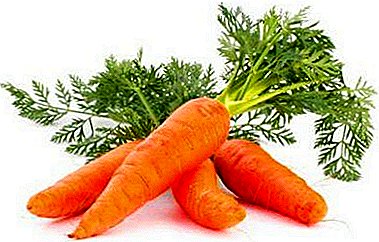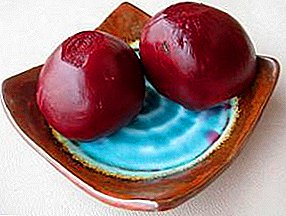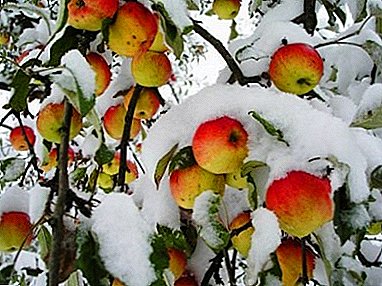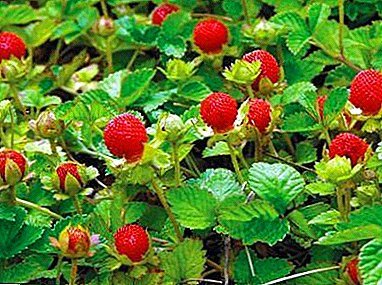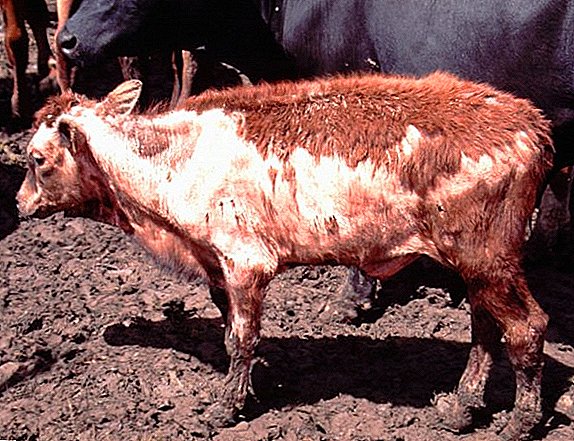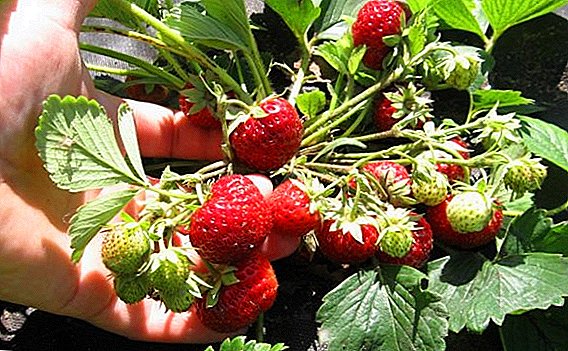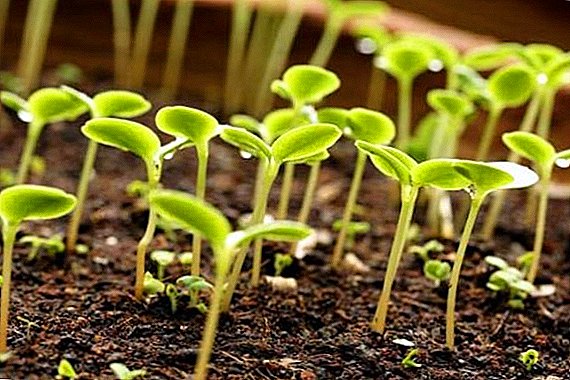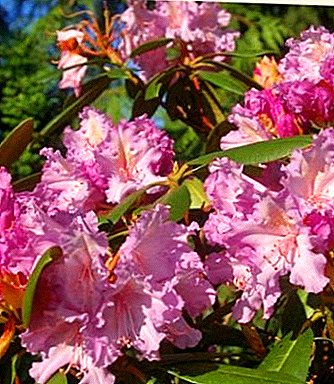
Almost a hundred years from Japan to Europe was introduced unusually beautiful shrub - rhododendron (azalea) percy vaisman yakushimansky. A small tree in the shape of a ball entirely covered with flowers is an incredible beauty.
Caring for him is simple, but some features of the content you need to know.
Appearance

The root system is superficial, so the plant does not tolerate loosening, digging, as well as flooding.
The leaves are narrow, thick, leathery, glossy. The color of the foliage is dark green above, brown below with slight pubescence.
The flowers have a diameter of up to 7 cm, gathered in inflorescences of 5-10 pieces. At the beginning of flowering petals pale pink, and by the end - a dazzling white. The azalea bloom begins in May and ends in June.
The height of an adult plant is up to one meter, the span of a crown is up to one and a half meters. The annual growth for the year is about 10 cm, so the shrub is considered to be slow-growing.
The Yakushima rhododendron is an evergreen tree that will please the eye with its dark emerald foliage both in winter and summer.
Types of rhododendron Yakushimansky
Today there are several types:
Almuth - height 80 cm, white flowers with reddish speckles, crown dome-shaped.
Anushka - 2 m high, flowers are saturated-pink.
Arabella - height is 1 m, flowers are very large, red with a white middle, the crown is spherical-flat.
Astrid - height is 1 m, flowers are bright red large, funnel-shaped, the crown shape is wide-round.

Blurette - Height 90 cm, flowers violet-pink with yellow specks, slightly corrugated at the edges, crown dome-shaped.
Kalinka - height 120 cm, flowers have a pink or mauve shade.
Marrakesh - height is 70 cm, flowers are very large, white-pink with specks. Silverboarder - height 1 m, white flowers with yellowish or greenish specks, crown dome-shaped.
Fantasy - 120 cm high, the flowers are large outside pink-red, and the inside is soft-pink.
Schneekrone - height 50 cm, white or pale pink flowers, crown dome-shaped.
Edelweiss - height is 70 cm, flowers are white with reddish inclusions.
Percy Weissman - 1 meter high, flowers are pale-pink with a peach shade, at the end of flowering petals become yellow-white.
Rhododendron Yakushimansky - planting and care
This plant is different good winter hardinesstherefore recommended for cultivation in the middle zone of our country.
It is important to keep in mind the rules of maintenance, because improper care can destroy the shrub.
 Landing
Landing
Best time to land of the Yakushimani rhododendron is end of aprilwhen the soil is completely warmed by the sun. You can also plant in the fall, in early September, when it is not freezing.
Azalea does not tolerate direct sunlight. Also a dangerous place for him to be open. a place subject to winds. The best location is the penumbra..
You can plant a rhododendron separate bush, and you can create a group composition. Such evergreen shrubs will decorate the garden.
 Priming
Priming
Azaleas prefer loose, acidic, humus-rich soil. You can prepare the soil yourself. To do this, take two parts of peat land, two parts of coniferous land and one part of river sand. When planting at the bottom of the hole it is desirable to put a drainage (expanded clay, pebbles, sand) in order to avoid stagnation of water.
Watering
Rhododendron Yakumashinsky - hygrophilous therefore, it is important to monitor the number of waterings. Watering takes place 2-3 times a week, in dry weather it is recommended to carry out spraying.
Temperature conditions
Frost resistance - This is a characteristic feature of this plant. It is able to withstand cold weather up to - 30 C. But it should be remembered that young seedlings need to be sheltered for the winter.
Fertilizer and dressing
For proper growth, rhododendron should be fertilized 3 times per season. The first time is before flowering (20 grams of fertilizer for feeding azaleas per liter of water), the second time right after it (with the same fertilizer), the third time at the end of August (25 grams of superphosphate and 15 grams of potassium sulfate). The third dressing is necessary for ripening the bark and preventing the formation of young shoots.
 Bloom
Bloom
The flowering of rhododendron of Yakushiman is extraordinarily beautiful, abundant. Flowers collected in inflorescences sprinkle the entire shrub. It begins at the end of May and lasts until the end of June.
Pruning
This plant does not need special pruning. But there are situations when it is important to do this, for example, to remove dead wood and dry branches.
After flowering, it is recommended to cut off flowering inflorescences for a variety of flowers next year.
Transfer
Azalea transplantation often takes place painlessly at any age, but it should be remembered that it is impossible to disturb the earthen room to avoid damaging the root system. The best time for a transplant is spring and autumn.
Breeding methods
There are several ways which one to choose - each gardener decides for himself.
 Seeds. Seeds are planted in January-February. Sowing occurs superficially in the nutrient soil. Shoots appear during the week.
Seeds. Seeds are planted in January-February. Sowing occurs superficially in the nutrient soil. Shoots appear during the week.
At a permanent place of growth seedlings are planted only in a year.
Cuttings. To obtain cuttings, it is necessary to cut off a twig 5 cm in size and having 3-4 internodes. Cuttings are placed in peat-sand soil. During the month rooting takes place and shoots and leaves appear.
 Layering. For this method of reproduction in the spring choose the lower branch, a little incise it and immersed under the soil. Layers it is important to water and pour nutrient soil. By mid-July, the layering will take root and it can be cut off from the mother bush and transplanted to another location.
Layering. For this method of reproduction in the spring choose the lower branch, a little incise it and immersed under the soil. Layers it is important to water and pour nutrient soil. By mid-July, the layering will take root and it can be cut off from the mother bush and transplanted to another location.
By division. An adult bush is dug out of the ground and divided into parts. Each part is planted separately. In 2-3 years the bush will fully recover and acquire its decorative effect.
Wintering
The Yakushimansky rhododendron perfectly tolerates low temperatures, therefore it does not require shelter for the winter.
But young shoots in the first few years after planting should definitely be covered.
To protect young bushes from frost should be covered with spruce leaves, and with a decrease in temperature, pour dry leaves on top.
Care for adult plants in the fall is as follows:
1. The last watering should be done before the first severe frosts to prevent dehydration of the root system.
2. The fall should be filled with mulch (peat, pine needles, dry leaves) with a layer of 10-15 cm near the bush to protect small roots from the cold.
Diseases and pests
Unfortunately, this luxurious plant is prone to many diseases:
- Phytophthalic rot. The leaves begin to turn yellow and fall off, the branches turn yellow, the roots rot, the plant begins to wither. For the prevention and treatment of this disease, it is recommended to treat with a solution of Bordeaux mixture.
 - Gray rot. Dark spots appear on branches, leaves, buds. Progressive disease leads to death. For treatment, it is necessary to spray a bush and soil with a 0.2% solution of foundationol.
- Gray rot. Dark spots appear on branches, leaves, buds. Progressive disease leads to death. For treatment, it is necessary to spray a bush and soil with a 0.2% solution of foundationol.
- Fusarium. The azalea begins to turn yellow sheet, rots the trunk and root. It is possible to get rid of this disease by spraying with a 0.2% solution of basezol.
Rhododendron has a lot of pests too:
- Rhododendron bug. Yellowish dots can be found on the leaves. Foliage pales and falls. To get rid of this pest it is necessary to make spraying diazinon.
- The Redhead. You can find it on young stems, buds, buds. The pest sucks the sap of the plant, which is why it lags behind in development, sheds leaves and may die. Spray karbofos will help to save the tree from the bite.
- Spider mite. It affects the foliage, eats juice. The leaves turn gray and fall off. For the prevention and destruction of spider mites, spraying with Keltan 0.35% emulsion is performed every 6 days.
Possible difficulties in growing
 - Bud fall. This is due to insufficient water. To avoid this, you need to carry out regular watering, to prevent the drying of the soil.
- Bud fall. This is due to insufficient water. To avoid this, you need to carry out regular watering, to prevent the drying of the soil.
- Weak flowering, small leaves, red spots along the leaf veins. This is a sign of nutritional deficiencies. Applying top dressing in the form of potassium nitrate will help to cope with this problem.
- Small yellowed leaves and slow growth indicate a possible gulf.
More and more often in the gardens you can find beautiful shrubs of the Yakushiman rhododendron. Flower growers fell in love with him for its frost-resistant qualities, not very complicated care, and unique flowering.
A photo
More photos of the Yakushimansky rhododendron see below:




Useful information
You can read other materials on the topic and learn more about azaleas / rhododendron:
- Ways to grow azaleas at home: growing rhododendron
- Beauty in your home! How to dilute the hydrangea room at home?
- Azalea - green beauty in your house
- Gentle clouds land in June: rhododendrons (azaleas) in garden culture



